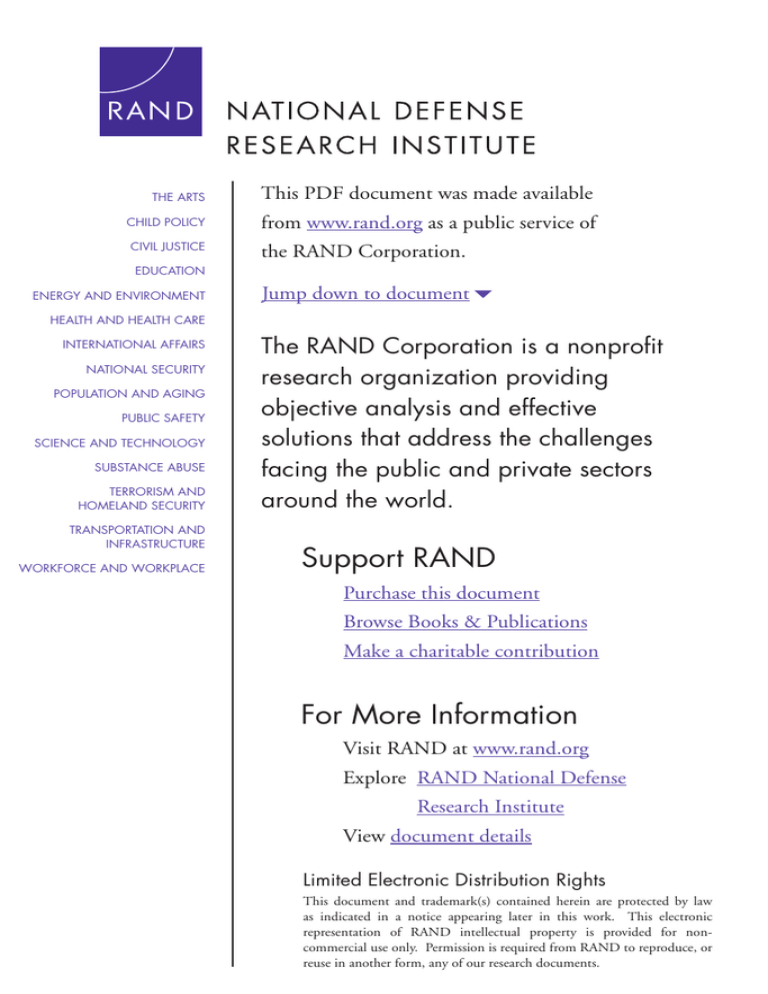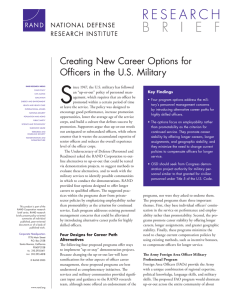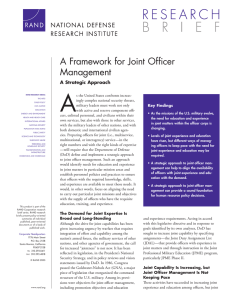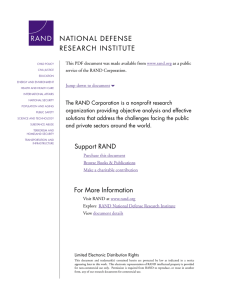
THE ARTS
This PDF document was made available
CHILD POLICY
from www.rand.org as a public service of
CIVIL JUSTICE
the RAND Corporation.
EDUCATION
ENERGY AND ENVIRONMENT
Jump down to document6
HEALTH AND HEALTH CARE
INTERNATIONAL AFFAIRS
NATIONAL SECURITY
POPULATION AND AGING
PUBLIC SAFETY
SCIENCE AND TECHNOLOGY
SUBSTANCE ABUSE
TERRORISM AND
HOMELAND SECURITY
TRANSPORTATION AND
INFRASTRUCTURE
WORKFORCE AND WORKPLACE
The RAND Corporation is a nonprofit
research organization providing
objective analysis and effective
solutions that address the challenges
facing the public and private sectors
around the world.
Support RAND
Purchase this document
Browse Books & Publications
Make a charitable contribution
For More Information
Visit RAND at www.rand.org
Explore RAND National Defense
Research Institute
View document details
Limited Electronic Distribution Rights
This document and trademark(s) contained herein are protected by law
as indicated in a notice appearing later in this work. This electronic
representation of RAND intellectual property is provided for noncommercial use only. Permission is required from RAND to reproduce, or
reuse in another form, any of our research documents.
This product is part of the RAND Corporation monograph series.
RAND monographs present major research findings that address the
challenges facing the public and private sectors. All RAND monographs undergo rigorous peer review to ensure high standards for
research quality and objectivity.
Challenging Time
in DOPMA
Flexible and Contemporary
Military Officer Management
Peter Schirmer, Harry J. Thie, Margaret C. Harrell, Michael S. Tseng
Prepared for the Office of the Secretary of Defense
Approved for public release; distribution unlimited
The research described in this report was prepared for the Office of the
Secretary of Defense (OSD). The research was conducted in the RAND
National Defense Research Institute, a federally funded research and
development center sponsored by the OSD, the Joint Staff, the Unified
Combatant Commands, the Department of the Navy, the Marine Corps,
the defense agencies, and the defense Intelligence Community under
Contract DASW01-01-C-0004.
Library of Congress Cataloging-in-Publication Data
Challenging time in DOPMA : flexible and contemporary military officer management
/ Peter Schirmer ... [et al.].
p. cm.
Includes bibliographical references.
ISBN-13: 978-0-8330-3948-4 (pbk. : alk. paper)
1. United States—Armed Forces—Officers—Management. 2. United States—
Armed Forces—Personnel management. I. Schirmer, Peter, 1970– .
UB413.C53 2006
355.3'320973—dc22
2006020173
The RAND Corporation is a nonprofit research organization providing
objective analysis and effective solutions that address the challenges
facing the public and private sectors around the world. RAND’s
publications do not necessarily reflect the opinions of its research clients
and sponsors.
R® is a registered trademark.
© Copyright 2006 RAND Corporation
All rights reserved. No part of this book may be reproduced in any
form by any electronic or mechanical means (including photocopying,
recording, or information storage and retrieval) without permission in
writing from RAND.
Published 2006 by the RAND Corporation
1776 Main Street, P.O. Box 2138, Santa Monica, CA 90407-2138
1200 South Hayes Street, Arlington, VA 22202-5050
4570 Fifth Avenue, Suite 600, Pittsburgh, PA 15213
RAND URL: http://www.rand.org/
To order RAND documents or to obtain additional information, contact
Distribution Services: Telephone: (310) 451-7002;
Fax: (310) 451-6915; Email: order@rand.org
Summary
Background
The RAND National Defense Research Institute (NDRI) has studied
changes to law and policy that would support the Secretary of Defense’s
desire to have officers serve longer in their assignments and in their
careers. NDRI began by studying how assignments and careers could
be lengthened for general and flag officers (grade O-7 and above).1 A
key finding was that some, but not all, jobs and careers could be lengthened without significantly affecting promotion opportunity through
the grade of O-9 (lieutenant general or vice admiral). The second phase
of the study, the findings of which are presented in this monograph,
examines how assignments and careers could be lengthened for activeduty officers in grades O-1 through O-6. The general and flag officer
phase of the study focused on which jobs to lengthen and for which
officers; the current phase of the study focuses on how to enable officers
to have longer assignments and longer careers through changes in law
and policy.
Many of the laws and policies that govern officer career management (commonly, if somewhat inaccurately, referred to as DOPMA,
after the Defense Officer Personnel Management Act of 1980) have
been in place for at least the past quarter-century. The Defense Officer
Personnel Management Act was more evolutionary than revolutionary. It built upon legislation from the 1940s and 1950s, and some of
1
Margaret C. Harrell, Harry J. Thie, Peter Schirmer, and Kevin Brancato, Aligning the
Stars: Improvements to General and Flag Officer Management, Santa Monica, Calif.: RAND
Corporation, MR-1712-OSD, 2004.
xiii
xiv
Challenging Time in DOPMA
its key sections incorporated ideas and policies that had been around
since the 1960s or even earlier (up-or-out, for example, has been a Navy
policy since the beginning of the 20th century, and mandatory retirement at age 62 dates back to the Civil War). DOPMA has served the
needs of the services reasonably well, but there is a growing sense that
the current personnel-management system may not meet the requirements of the future operating environment. One of the criticisms of
the DOPMA system is that it does not allow for much variety in the
career paths of most officers. Under the DOPMA system, decisions
about assignments, promotions, and retirements are driven by timebased laws and policies that are applied more or less uniformly across
the services. As an alternative to the current time-based system, the
emerging focus in defense planning and in the services’ human capital
strategies is on knowledge, skills, and abilities—i.e., officer competencies—as a basis for career management. The focus on managing officer
competencies could require a system with greater flexibility that would
enable certain officers to have longer assignments and longer careers.
Although the expectation by the Office of the Secretary of
Defense is that greater flexibility in career management could improve
organizational outcomes and individual performance, it is beyond the
scope of this research to forecast or predict such effects. We do not
attempt to determine optimal assignment or career lengths, nor do we
recommend specific assignments to be lengthened or identify types of
officers—e.g., specialists, fast-trackers, due-course officers (those whose
careers follow typical time lines)—who should have longer careers. We
focus on changes to law and policy that would enable the desired outcomes of a future officer career-management system, especially longer
assignments and longer careers.
Modeling Career Path Alternatives
We examined the outcomes of extending assignment and career lengths
in a time-based system and compared them with the outcomes of
extending assignment and career lengths in a competency-based system.
To make that comparison, we modeled the flow of officers through the
Summary xv
system in a variety of scenarios. We used the current system as a baseline, and then we examined various scenarios that extend assignments
and careers for specific communities within the military services: surface warfare officers in the Navy, infantry officers in the Army, space
and missile officers in the Air Force, and Marine officers who are not
aviators.
For each of these communities, we produced baseline results using
a set of inputs specific to each community and the laws and policies (or
“business rules”) that govern the officer career-management system. We
refer to these inputs as our Baseline Scenario. We then changed some
of the business rules and compared the new model results with the
results of the Baseline Scenario and with other scenarios, as was appropriate. Table S.1 lists the various alternatives. The Baseline Scenario
and Scenarios 1, 2, and 3 use the DOPMA time-based rules; Scenarios
4, 5, and 6 apply a more flexible set of promotion policies that allow for
more-varied time to promotion.
Trade-Offs Between Breadth and Depth in Different
Systems
The DOPMA system is a time-based management system with relatively fixed career “flow points.” The fixed flow points compel a tradeoff between the length and the number of assignments, or between
Table S.1
Comparison of Model Scenarios
Scenario
Baseline
1
2
3
4
5
6
Assignment
length
Status
quo
Longer
Longer
Longer
Status
quo
Longer
Longer
Career
length
Status
quo
Status
quo
Longer
Longer
Status
quo
Status
quo
Longer
Time to
promotion
Status
quo
Status
quo
Status
quo
Longer
More
varied
More
varied
More
varied
xvi
Challenging Time in DOPMA
what could be called officers’ depth and breadth of experience. If officers have longer assignments (greater depth), they will have fewer
assignments within a fixed period of time (less breadth). Lengthening
careers will allow officers to regain some lost breadth by giving them
more time for additional assignments. However, unless promotion
timing also changes, lengthening careers provides additional time only
in the grade from which an officer separates or retires; officers will still
have fewer assignments until they reach their final grade. These officers, therefore, may not bring the appropriate breadth of experience to
key assignments throughout their career. Delaying promotion timing
allows officers to have additional assignments mid-career, but, under
DOPMA, it is difficult and cumbersome to delay promotions selectively for some officers but not for others.
A more flexible system would allow for longer careers and would
have wider promotion zones. Conceptually, such a system manages
careers according to competencies rather than according to time.
The key distinctions between a competency-based system and today’s
time-based system are the rules governing eligibility for promotion:
Accumulated experience gained through jobs, education, and training
would make officers eligible for promotion. There would be no primary
promotion zone, based on seniority, from which most officers would
be selected. The services and service communities would determine
the experiences that would lead to promotion eligibility; presumably,
those criteria would reflect current career guidelines. We would expect
to see “due-course” promotions distributed over multiple years for a
single grade and perhaps even some overlap in the timing of promotions to different grades. While there would be greater variation in
outcomes for individuals, average outcomes would probably resemble
current average outcomes if promotion eligibility criteria reflect current
career guidelines.
A competency-based system can accommodate longer assignments
for some officers, but if a large number of assignments are lengthened,
the amount of time required to accumulate work experience that leads
to promotion eligibility could increase significantly. As a result, either
careers must also be lengthened or the promotion eligibility criteria
must be changed. The latter option is similar to what would happen
Summary xvii
with longer assignments in a time-based system: With longer assignments and fixed promotion timing, officers would have fewer assignments in each grade. A competency-based system can also accommodate additional assignments or education for some officers who may be
at a disadvantage relative to their peers if they have such assignments
in the current system.
Implementing a Competency-Based Career-Management
System
Making aspects of DOPMA more flexible to allow for officer career
management on the basis of competency rather than time will not
require drastic changes to law or policy. The key phrase in Title 10 of
the U.S. Code that compels a time-based promotion system is “failed
of selection,” which is applied to officers not selected for promotion
while in the primary promotion zone with their peers. Among other
things, the phrase has implications for how promotion zones are constructed and how officers are involuntarily separated or retired. Even
without changing Title 10, DoD could provide the services with more
flexibility in managing officer promotions by rewriting its directives
and instructions to omit references to desirable promotion timing and
further clarify that it is acceptable policy for competitive categories
to have different promotion timing and promotion opportunity. This
would be only a partial solution, because it does nothing to address
career lengths and allows only for greater variation across competitive
categories, but not within them.
The greatest amount of work in implementing a competencybased system will fall to the services and the service communities.
Greater flexibility does not mean greater ease of management; the
opposite is probably true. The biggest challenge will be in identifying the knowledge, skills, and abilities (KSAs) that are conferred and
required by each job, school, and training event. This is not a one-time
effort, particularly on the demand side. Changes in the geopolitical
environment, in technology, and in society have a continual influence
on individual competencies that generate the capabilities of military
xviii
Challenging Time in DOPMA
organizations. Although we modeled a system in which officers are
assumed to develop competencies by virtue of their having had particular assignments, a complementary or alternative policy would be to
individually assess officers to determine whether the KSAs have been
conferred or developed to the desired level. Assessments could differentiate individuals not only by professional experience but also by the
KSAs actually gained or improved through that experience.
Implementation of a competency-based management system may
not result in significantly different outcomes for many officers, should
the services and service communities believe that current outcomes
yield the right types and mixes of competencies for certain groups
of officers. The extent to which outcomes vary across individuals or
average outcomes shift depends in part on whether assignments and
careers are lengthened and by how much. Variation of outcomes might
also depend on whether individual assessments are used to determine
whether individuals have desired competencies.
Fairness and credibility among the officer corps are the sine qua
non of a new career-management system. Officers must believe that
they are being treated fairly and that the new system produces officers who are at least as effective and credible as those produced by the
old system. Explicit and implicit contracts—the terms of the “deal”
between officers and the institutions that they serve—may need to
change as more information about the changing environment and
about officer behaviors is known. However, one virtue of the proposed
personnel-management system is its flexibility. Rather than specifying
a single prescription for officer management as most previous systems
have done, we suggest creating boundaries within which managers can
reshape the deal as needed to adjust to changing environments and
changing needs. We would also argue for a gradual implementation of
many of these practices over a period of years, so that the deal can be
viewed as evolving and designed to meet the needs of both officers and
their organizations and institutions. Gradual implementation is also
recommended, because what is known today about required competencies, particularly for more-senior positions, is often based on subjective assessments and not necessarily on a more systematic evaluation
of competencies, how frequently those competencies are employed in
Summary xix
an assignment, and the importance of those competencies to job performance. As the system gradually evolves, so, too, should the services’
ability to manage officers’ competencies to meet the diverse operational
needs of the 21st century.







